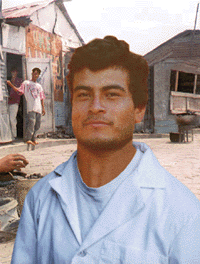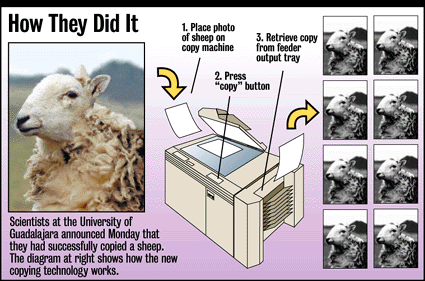| | | Onion Merchandise & Subscriptions | | | | |
|
|
|
GUADALAJARA, MEXICO--The world's scientific community is reeling in the wake of Monday's announcement that scientists at the University of Guadalajara have successfully copied a picture of a sheep.
 | |
| Above: Professor Felipé Padilla, seen here in front of the science building on the University of Juarez campus, believes that copying can do much good, if properly harnessed. |
"This is extremely exciting," said team leader Professor Manuel Cortines. "We have created a precise duplicate copy of a sheep picture, identical in every way to the original. Except that it is not color."
The University of Guadalajara team produced the copy Friday morning by placing a photographic image of the sheep onto a special copying device, which distributes countless dry ink particles onto a piece of paper.
"At the touch of a button," Cortines said, "we can have many sheep."
For the Guadalajara scientists, Friday's breakthrough represented the culmination of years of experimentation with copying. In 1991, Mexican scientists, working closely with local printers, achieved a successful "tracing," a drawing of an image on a clean sheet of paper over an existing image.
In 1994, the group almost successfully copied a sheep by applying ink to its body and pressing the animal against a giant sheet of paper, but the researchers were unable to hold the sheep still long enough to make a clear copy.
"The sheep would squirm and kick, often knocking over the ink wells, soiling the paper before a clean pressing could be made," Cortines said. He added that, under duress, sheep can exert surprising strength.
Previously confined to the realm of the imaginations of Mexican science-fiction writers, copying is now the subject of much debate across the nation, as Mexico's leading thinkers ponder its potential uses.
"Copying, if properly harnessed, can do much good," said University of Juarez professor Felipé Padilla. "For instance, if you were to have a party, and you wanted to invite 50 people, you could hand-write one invitation, and then make as many copies of it as you like."
Padilla also touted copying's potential benefits for Mexican businesses. "Signs could be printed saying, 'Have your picture taken with this donkey painted like a zebra--only 30 pesos,'" Padilla said. "In theory, there is no limit to the number of donkey-painted-like-a-zebra acts which could utilize such a sign."

It may also be possible, some medical practitioners believe, to use copies to save lives on the operating table. A copy could be made of a kidney dialysis patient's good kidney, and then the copy could be inserted into the patient's body cavity, replacing the bad kidney.
While many are excited about the new technology's potential for good, others fear that copying could be badly misused.
"There is a great danger that copying could be used for evil," said Mexican author Roberto Palacios. "What if someone harnessed this new technology to create hundreds of copies of a single resumé? There would be no limit to the number of potential employers who could review the qualifications of such a person. Such an applicant would have an enormous, unfair advantage over other prospective applicants."
Will it someday be possible to copy a human? The question causes great concern among leading Mexican bioethicists.
"What if someone were to copy Hitler? There are many pictures of him in books and magazines. If such pictures were to fall into the wrong hands, I fear to think what might happen," said Emilio Vargas, head of Mexico City's Insitutia Por Los Thinking.
"There is even talk of an 'enlargement' button, which could double or even triple the size of anything," Vargas continued. "I pray each night that such a frightening button never comes to pass."
Despite the concern, the Guadalajara scientists stress that the copying of pictures of humans is still far off.
"There are many problems to work out with this new technology before we can even consider copying a human," Cortines said. "Just yesterday, an attempt to copy a second sheep was derailed because of a paper jam. We also have yet to develop a replacement cartridge for the toner. When the current one runs out, our work may be set back years."
The Mexican government has pledged $45 to the University of Guadalajara copying project, which will be used to pay the researchers' salaries and refill the paper tray.
|
|
|
| | |
| © Copyright 2001 Onion, Inc., All rights reserved. | | | |